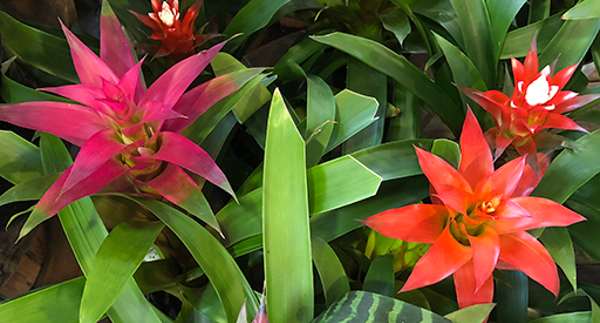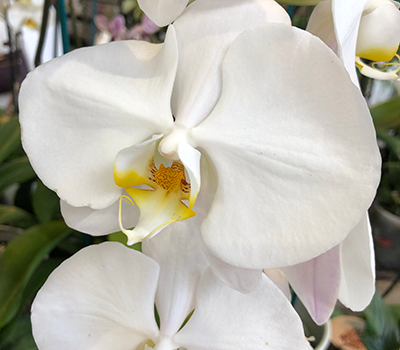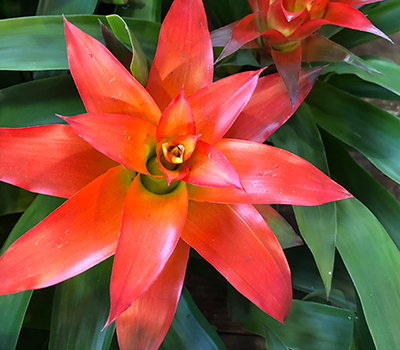
Orchids and Bromeliads are truly beautiful, exotic plants that make a wonderful addition to your indoor plant oasis. Just like plants growing outdoors, indoor plants also need regular TLC. See our tips below for keeping your orchids & bromeliads in top shape.
caring for your orchids
Planting
- Ensure orchids are planted in a free draining potting mix. Tui Indoor Plant Mix is a free draning mix that contains a starter fertiliser to provide instant nutrients and prevent transplant shock, along with a controlled release fertiliser for sustained feeding for up to six months.
Light
- Place orchids in a warm, bright, well lit position. Orchids will tolerate a few hours of direct sunlight per day. Some varieties of orchids may require different amounts of light, so refer to the plants specific growing requirements for the best position.
Watering
- Regularly water orchids 2-3 times a week when they are flowering, or reduce watering to once a week when they are dormant. Avoid over watering as this can cause root rot, and allow plants to dry out between watering.
- Orchids enjoy a humid environment, so regularly mist the leaves or place the plant in a saucer of damp pebbles to increase humidity.
- Orchids will benefit from a rest period over winter, so minimise watering.
Feeding
- Feed your orchids every 2 weeks in spring and summer with Tui Enrich Pour & Feed Orchid & Bromeliad fertiliser, a premium formulation designed with vital nutrients to promote optimum flowering and healthy green plant growth.
- Orchids will benefit from a rest period over winter, so minimise fertilising.
Pests & Diseases
- Insect pests such as mealy bug, root mealy bug and scale can sometimes be a problem. Use Tui Indoor Plant Insect Spray to control. Apply when infestations are first noticed and then weekly while insects are active.
- Avoid over watering orchids, especially in winter as this can cause root rot.

caring for your bromeliads
Planting
- Plant bromeliads in a free draining mix. Tui Indoor Plant Mix is a free draining mix that contains a starter fertiliser to provide instant nutrients and prevent transplant shock, along with a controlled release fertiliser for sustained feeding for up to six months
Light
- Place bromedliads in a warm, bright, well lit position, some will tolerate direct sunlight. Whether plants are epiphytic or non epiphytic determines the level of light they require, so refer to plants specific growing requirement for the best position. The more colourful the leaves on the plant, the more direct sunlight they require.
- Bromeliads require a warm room temperature all year round and high humidity when they're actively growing in spring and summer.
Watering
- Bromeliads use their roots for anchorage, and water and nutrients are absorbed through the leaves and the spaces between the leaves. It is important to keep the central cup (rosette) full of water at all times.
- Water the surface of the potting mix moderately, allowing it to dry out between watering.
- Regularly mist the leaves or place the plant in a saucer of damp pebbles to increase humidity.
Feeding
- Feed bromeliads once a month when they are actively growing with with Tui Enrich Pour & Feed Orchid & Bromeliad fertiliser, a premium formulation designed with vital nutrients to promote optimum flowering and healthy green plant growth. Pour fertiliser into the central cup, onto the potting mix or fertiliser can be splashed over the leaves.
- Allow plants to rest over winter by reducing watering and feeding, however maintain a full central cup in rosette types.
Pests & Diseases
- Bromeliads are relatively pest and disease free, however prolonged cold temperatures below 13 degrees Celsius will cause damage to the leaves.

Post a comment
Top Tips for Orchids & Bromeliads Comments
The info about bromeliads is timely. I have 2 and find them good to have inside at the moment. My home is small and not particularly warm so find it difficult to have indoor plants. I have watered the bromeliads as instructed, however the top of one is becoming brown but there are young shoots coming up from the base, good, but what do I do with the plant please?
Suzanne MacFarlane
Hi Suzzane, eventually the parent plant dies and the pups emerge from the side. The pups can be removed and planted into a well drained potting mix and put in a pot. Use a sharp knife to cut the pups as close to the parent plant as possible.
Tui Team
Thank you for the answer, I shall seperate the babies and replant them into their own pots.
Suzanne MacFarlane
I have always grown my Bromeliads outside but after reading this I will try some of my favourites inside. Thank you
Barbara Crawford